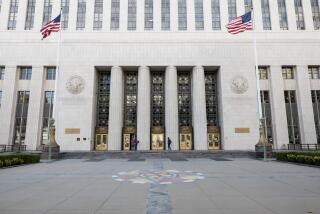Gypsy Supreme Court Gets Down to Business
- Share via
WASHINGTON — The Supreme Court justices, forced out of their building by fears that anthrax had arrived via the mail, spent Monday morning arguing over the constitutional significance of putting a letter in the mail.
The argument session itself marked a footnote to history. It was the first time since the Supreme Court moved into its own building in 1935 that the justices had sat elsewhere as a court.
They moved a few blocks away to the federal courthouse that sits near the foot of Capitol Hill. They are expected to meet there most of this week.
Spokeswoman Kathy Arberg announced that a trace of anthrax was found over the weekend in the court’s basement mail room. “All tests in the rest of the building were negative,” she said.
The weekend testing was triggered by a report Friday that an air filter at the court’s remote mail handling center had tested positive for anthrax.
The test results suggest two possibilities. The first is that a letter containing anthrax spores was sent to the high court and, so far, remains undiscovered. If so, this could pose a serious risk to many of the court’s employees.
The second possibility is that some of the court’s mail traveled through the Brentwood postal facility here and picked up traces of anthrax at that site. If so, the risk may be minimal.
Either way, the justices were determined to keep to business as usual. They were scheduled to hear arguments in six cases, as well as issue their usual list of orders disposing of dozens of pending appeals.
The first case heard Monday sounded like a version of “the check is in the mail” quandary.
The question before the court, coincidental to the anthrax scare, was this: Are people who are about to have property seized by the government entitled to receive notice of the legal action, or is it enough for the government to say that it put a notice in the mail?
The case before the court arose when Larry Dusenbery, an imprisoned drug offender from Ohio, sued because he had not received notice that his car and $21,000 in cash had been seized by the government.
His lawyer, Allison Zieve, argued that the lapse violated the Constitution’s guarantee of “due process of law.” A notice may have been sent to Dusenbery, but prison officials may not have given it to him.
She said the court should require that the government use certified mail and obtain the inmate’s signature as proof he received the letter.
But the Justice Department said this requirement goes too far. “Our position is that ordinary mail is sufficient,” said Jeffrey Minear, an assistant to the solicitor general. “It poses a burden for the government” if officials must see to it that the notices are actually received, he said.
New courtroom aside, the justices wasted no time in reverting to form as soon as arguments began.
Chief Justice William H. Rehnquist and Justice Antonin Scalia sided with the government’s lawyer.
They said they feared a wave of new lawsuits if inmates and others can file suits claiming they failed to receive a required notice. “This sort of thing can come years later,” Rehnquist said, and make for messy litigation.
But Justices David H. Souter and Stephen G. Breyer took up the inmate’s claim. “Maybe I’m missing something, but I don’t see the difficulty,” Souter said. If the government sent a certified letter and obtained a signature from the recipient, it would solve the problem, he said.
By the end, the justices sounded closely split. The outcome in Dusenbery vs. U.S., 00-6567, could affect members of the armed forces and hospital patients, all of whom must rely on large mail rooms to deliver their letters.
More to Read
Get the L.A. Times Politics newsletter
Deeply reported insights into legislation, politics and policy from Sacramento, Washington and beyond. In your inbox twice per week.
You may occasionally receive promotional content from the Los Angeles Times.











